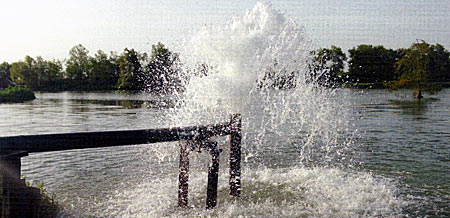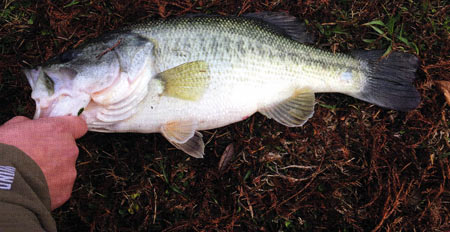
On this project, there are no pieces to pick up.
It was an utter failure.
After three years of doing everything they were supposed to do, the lake collapsed.
Here's the story, and as you read, look for clues that could have prevented this mess—and maybe prevent yours.
In south Louisiana, there's a lake covering about 26 acres. It sits above ground, surrounded by a levee. A shallow, high volume well fills the mostly shallow lake, and other than that, the only water they get falls straight down from the sky. That's 60+ inches per year.
In the middle of the lake grows more than a hundred cypress trees.
Birds roost in those trees—big numbers of migratory species, along with permanent populations of egrets and shore birds that come and go all year long.
Like many similar lakes in flat country, the levee was built by excavating the perimeter of a field, so a channel sits around the perimeter, and the middle of the lake was shallow, averaging slightly deeper than three feet.
I was approached by the company that owns it, asking what they could do to make this water body into a nice fishing lake.
After a couple of site visits, we began devising a plan. As their consultant, my job was to guide them through a process of decisions to turn this shallow, overly-vegetated, beautiful lake into a bass fishery.
Job One was to drain the lake and do some renovations. With a finite budget set for dirt work, the decision was made to take approximately one-third of the lake and rearrange dirt to create the best habitat for Largemouth bass and bluegill. With the water out, and incessant rainfall followed by pumping, it took months to reclaim that part of the lake. With the Cyprus trees exposed in the middle of the lake bed during this process, company representatives decided they wanted to keep those for their aesthetic appeal. No trees were removed. They were cautioned to keep birds away, primarily because no one wanted fish to be eaten before they could grow into a fishery, but also because birds and fish just don't mix well. Other than that advice, management followed their plan to a tee. They created spawning beds, added structure, cover, and habitat. They purchased an aeration system for the newly renovated part of the lake—they did everything they were told to do.

Job Two was to create a fast-track fisheries management strategy to grow nice bass and bluegills where novice-to-expert anglers could enjoy the fishery.
A feeding program was included.
When the dirt work was finished, and the revived lake pumped full of fresh, clean well water, it was stocked with appropriate numbers of bluegills, redear sunfish, and fathead minnows, followed shortly by advanced bass fingerlings, some of which were feed-trained.
The fish grew like crazy.
For three years, with a consistent feeding program, and water kept fertile by nature's input on top of the feeding program, the fishery was thriving.
Photos of happy people catching happy fish came often. When my phone pinged, it was often a photo of someone with a nice bass or big bluegill. A number of those pings came from people enjoying this lake.
The lake manager kept me abreast of conditions. After winter number two, bluegill numbers had dropped significantly. The originally stocked bluegills, a mix of coppernose and natives, were pushing 8-10 inches, verified by electrofishing the prior fall, and the best bass were headed toward three pounds. With plentiful bluegill habitat in the untouched areas of the lake, I expected them to thrive and survive.
Another clue for you. Black crappie were also stocked.
Where did those bigger bluegills go? The head decision-maker, to this day, is convinced they were eaten by bass. I'm not convinced of that at all. A large percentage of bass were not big enough to eat eight-inch bluegills. While I can't tell them what happened to those big bluegills, they stand convinced they were eaten by bass.
Then, midway during the second year, a few bass died and floated up in an isolated, deep hole. That hole is defined by a spit of land mostly cutting it off from the main part of the lake. Some sunfish died, too. Classic signs indicated an oxygen depletion. That occurred late summer, about the time a lake, especially one in the southern part of the nation, is most likely to have a depletion. None of the rest of the lake was affected. It still was a bit mysterious, because the lake should still act new after a renovation and having been filled with fresh water for only eighteen months.
While that minor event bothered me, my opinion was it was an isolated event, and with cooler months in front of us, a heavy algae bloom would mitigate.
The site manager kept me updated of lake water color and visibility, and we did regular water chemistry analysis—but only for metals, minerals, and basic nutrients such as nitrates, nitrites, phosphates, and sulfates. All those parameters were normal.
Visibility seemed to hover around 18 inches most of the year, but the green color would shift shades.
We had them restock bluegills and keep feeding. Bass relative weights were above 100, meaning their bass were thriving.
Then, last December, the lake manager was texting that the visibility kept dropping and was hovering between 16-18". Water temperature was between 48-55 most of the time, with ranges up into the mid-60s. Then a cold front would pass, and water temperature would drop into the mid-40s and stay there for a few days. Next, a high-pressure system would push through, creating a rise in temperatures back into the 60's.
Then, in early February, a perfect storm of events proved the catalyst to be catastrophic.
A cold front pushed through, sending temperatures into the 40's, followed by fast rises.
Then, back to back frontal systems pushed heavy amounts of rain on top of the lake.
The wintertime plankton bloom crashed, algae died, and so did the fish.
It was a catastrophic fish kill, in the middle of winter, in the south.
Management isn't happy with me, and I don't blame them. While day to day management of the lake ultimately lies with the owner and staff, they count on their professionals to guide them through the tough times.
I missed the symptoms. Being eight hours away, and not anywhere near the site, I was trying to depend on vague verbal descriptions of what the lake manager saw. Not thinking deeply about the potential of having a serious problem, I missed it—until it was too late. I've never seen a major winter fish kill in the south. It just doesn't happen.
Well, yes it does.

Any of the clues in this narrative strike a nerve with you?
Here's what we did, after the fact. During the fish kill, I called a colleague, a pond manager not far away. He took an oxygen meter and there were no readings above one part per million anywhere on the lake. Water was an ominous, unhealthy brown color. Preserved samples were sent to a microbiologist overnight. He found no species of algae, none, zero. Just remnants of broken bacterial cells.
What happened? What could we have done to prevent this event? Were there precursors we missed?
Needless to say, corporate managers are none to happy with yours truly. They've counted on me to guide them to a great fishing lake. Instead of enjoying the fruits of their three years of effort and money spent, we have to pick up the pieces and start over. They should be catching nice bass and big bluegills on a fly rod this spring, not dealing with this.
So, what was the problem?
A combination of factors contributed to rapid water quality degradation. Heavy input of nutrients from birds, combined with fertile soils left in the lake during renovation, set the stage for nature to do what nature does. This lake turned from having the potential to become a great fishery to septic tank. Heavy algae blooms did what they do to consume hot nutrients, that stuff rolling out of the backside of too many birds. Add the fact that zero soils were removed from the lake, and consider the accumulation of nutrients for years, and it all starts to make sense. To complicate the issue even more, I'm wondering if they had a bloom of toxic blue green algae or even golden algae during the coolest months. By the time we got samples, the fatal evidence was gone.
One of my favorite personality traits is my optimism. I totally expect every lake to thrive to its best ability, with some guidance and a thoughtful plan. That trait is also one that contributed to this problem. Had I been thinking more in-depth about the potential for disaster, my advice would have been different. But, I didn't. I kept thinking, "This little event will pass, and we'll get through winter." And, when we live seven hours away, and only see the lake maybe once a year, there were a lot of signs we might otherwise have seen.
Had I known the managers weren't able to keep birds from the trees, my advice would have been different. Had I personally seen thousands of birds congregate to roost on that lake every day, I would have counseled differently. But, I didn't know, comprehend, think about, or see that. I was told that depredation permits were no longer awarded, but didn't think about huge amounts of birds contributing to the eutrophication of that lake. I missed that. Didn't see it, didn't think to ask. Not smart.
Where do they go from here?
The recommended plan, as I write this story, is to restock the lake, and employ a local pond management company to do regular water chemistry checks and track the density and assemblage of algae blooms all year, capturing and analyzing samples bi-weekly to track trends. As algae densities rise, they need to be prepared to take remedial action. They'll have four basic tools at their disposal. One will be to knock the algae back with herbicides. A second will be to monitor and use products designed to manage nutrient levels to keep those in balance so they only grow good algae. A third will be to flush water with the well. The fourth will be to use the best combination of microbes to help keep excess nutrients flowing through the decomposition process. Another recommendation is to aerate the entire lake, not just the renovated part.
Will it work?
Time will tell.
Here's the bottom line for you. This entire ecosystem starts with the health of water. When water quality degrades, fish are at risk. That's why pond managers nationwide caution against populations of geese and ducks. That's why pond experts teach people to take care of the water—first.
In this case, a great fishery with an outstanding future was cut short—because water quality wasn't properly observed, managed, and prepared.
Now, we pick up the pieces.. .oh, wait.. .there are none.
Now we start over, with a sharper focus on keeping the water healthy.
Reprinted with permission from Pond Boss Magazine



